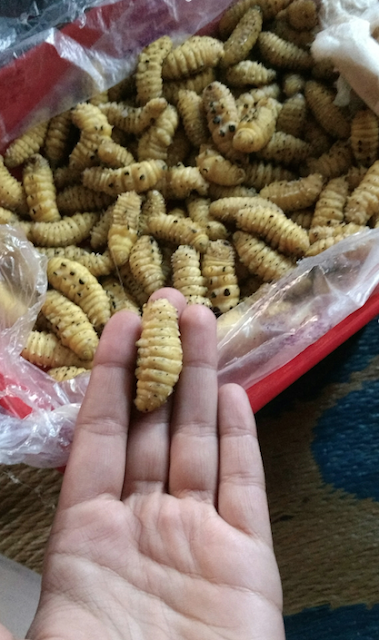Meal in the Plains: Khweng, Part 2 -- Bugs!
There are only two kinds of insects that are considered to be domesticated on a large scale.
I had already tasted one of them earlier in Shillong – bees.
And now in Khweng was my opportunity to try the other!
Khweng is a silk-producing region in Meghalaya, so almost every family in the village rears silkworms in their homes.
 |
| Soft, squishy, yellow silkworms -- they looked and felt almost adorable and cuddly! |
Most homes have small rearing rooms in their backyard. Eggs laid by the Eri moth grow into larvae, and then silkworms, which begin to munch away on bunches fresh castor leaves from their gardens (called Era in Assamese, thus giving the silk variety its name). The worms eventually build cocoons in preparation for their metamorphosis into moths.
While most homes in Khweng only grow silkworms and hand-spin the fibre, Kong Rikynti and her family, my hosts, were also skilled in dying and weaving the silk into shawls and fabric, which they sold around the country and the world.
 |
| My hosts, Kong Rikynti, her daughter Baiaikmen, and son Grateful |
In general, to spin long, unbroken silk in large-scale factories, the cocoons are boiled, killing the worms inside. However, in some parts of India like Andhra, Assam, and Meghalaya, the fibre is collected by an Ahimsa or 'non-violent' process.
There are a few ways in which Ahimsa Silk is processed. One is by allowing the full-grown moth to break open the cocoon, after which its silk is collected and spun.
Another, as practiced in Khweng, is to tap the cocoon until the worm peeks out from the top, then gently pull it out, so as not to hurt or kill it. The intact cocoons are then used to spin the silk. However, in this method, because these worms do not complete their metamorphosis process, their lifespan is cut short. With so many silkworms as a by-product, it seems almost criminal to waste their life by just throwing them away. So instead, these worms are used as a source of clean, lean dietary protein!
In this region, as in various other traditional silk-producing regions like China, Thailand and even the neighbouring state of Assam, silkworms are a popular snack or side dish with meals. In Khweng, they are boiled with bamboo shoot, or often fried. That night, for dinner, we had the latter.
Like most of the dishes I had eaten in the region, the preparation of the silkworm dish was extremely simple. Mustard oil was heated, and the soft, squishy yellow worms were dropped into the frying pan. They began to stiffen up. As they continued to slow cook they went from being soft, chubby, curled up worms, to becoming stretched out, like stiff fingers. They also began to get crisp, glossy, and golden brown. After about twenty minutes, they started popping like popcorn or roasting nuts, indicating that they were done cooking. Seasoned just with salt, they were served up with dinner.
 |
| The scrunched up worms expanded and stiffened as they cooked |
 |
| The crunchy, golden brown fried silkworms! |
The taste verdict? They were crunchy and salty. To me, they tasted a lot like dried, deep fried shrimp! They made for an interesting side dish with the chicken and wang curry, pond crab and bamboo shoot curry, and rice.
 |
| The meal: Rice, chicken and wang stem curry, pond fish and mud crab curry, some vegetables and of course, the silkworms! |
Were they gross and horrible? Not really, especially if you like dried shrimp. But would I eat them all the time? Maybe not. Insects are an acquired taste. I’m very open to trying new foods and so I didn’t allow the fact that they're – well, insects – to cloud my opinion. But that said, they definitely are an acquired taste.
Why was I so excited to try them? Entomophagy is a concept that is beginning to be talked about in many parts of the world as the 'sustainable food practice of the future'. Entomophagy advocators encourage people to substitute meat with insects. They are considered ecologically cleaner to cultivate, and nutritionally better to consume, containing less saturated fat and more micronutrients than meat. However, it isn't some new-fangled radical practice that some nutritionists invented and began advocating. Indigenous communities in almost all parts of the world have traditionally consumed insects in various forms for their flavour and nutritional value.
Entomophagy is a subject that really intrigues me, so I could go on with examples of traditional and modern insect-eating practices I have been learning about recently. But I shall reserve that for later.
As for my must-try ento-food list, the only two domesticated insects have been checked off, and next I hope to try red ant chutney from the Malnad region in Karnataka -- hopefully soon!
Comments
Post a Comment
Would love to hear your thoughts :)